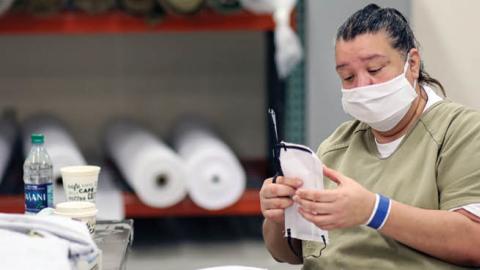Confirmation bias is common in policy arguments, and debates about COVID-19’s impact on American corrections systems are no exception. Many criminal justice reform advocates think that any inmate vulnerable to COVID-19 — regardless of sentenced offense or prospects for successful re-entry — should be released, while skeptics reflexively reject these calls to reduce prison populations. Under present circumstances, neither impulse is helpful.
For corrections, successful management of COVID-19 means many complex things, and minor delays in the smallest decisions can have damning consequences. Success should be defined as guaranteeing staff safety, minimizing inmate infections, maintaining a spread rate equivalent to or below the community’s, and limiting reliance on community medical resources.
Most American corrections systems have pandemic plans that COVID-19 has rendered insufficient. We have never seen a disease so highly contagious, with such a long incubation period, and transmittable by asymptomatic individuals. These alarming factors, alongside the high number of immunocompromised inmates, are ingredients for a crisis undeterred by prison fences. Social distancing measures are intended to keep the number of hospitalizations below the capacity of the community’s medical infrastructure. An outbreak in a prison, however, will significantly threaten that infrastructure. While social distancing is necessary inside correctional facilities, it will be ineffective without a population reduction strategy.
So, what have we learned about COVID-19 in corrections?
COVID-19 threatens correctional systems externally, unlike internal threats like escapes. Staff and visitors are the likeliest way for the virus to enter an inmate population, which is why most systems have eliminated visits and begun screening staff before they enter facilities.
COVID-19 is a “pressure test” for correctional systems. Like a garden hose on its first spring use, the system has cracks that leak under pressure. In corrections, the “cracks” that frequently fail under pressure are overcrowding, understaffing, and a limited medical infrastructure. In overcrowded prisons, social distancing is impossible, leading to increased spread rates. Meanwhile, alarming staff shortages prior to COVID-19 – with some systems exceeding 20% vacancy – have been exacerbated as staff fall ill. Finally, taxing correctional medical infrastructure – usually lacking ICU and ventilator capacity – means taxing community infrastructure. When inmates go to hospitals in the community, they are supervised by officers, further straining a taxed staff. An officer is more likely to contract COVID-19 in the hospital than in the prison, increasing risk to staff, their families, inmates and the community.
Corrections systems that employ early, aggressive, mitigation strategies have fewer cases and slower spread. Mitigation efforts should include minimizing the number of members of the public who enter facilities and screening them all for symptoms, including elevated temperatures, and for contact with suspected community infections. Other critical steps include masking staff and inmates, having inmates exit their cells in cohorts of 10 or fewer, and limiting movement throughout the facility. Many mitigation strategies are short-term. Lockdowns limit spread but can lead to mental health concerns, including anxiety, over the long term. Dorm-style or open housing units cannot even be “locked down.” We must develop additional solutions.
Lower inmate density means less spread. Therefore, population reduction is essential to managing this crisis. Systems should couple existing mechanisms with creative new strategies to reduce density. Already, executive branches have expanded compassionate release and commutations, but long-term legislative solutions are clearly necessary as well.
Re-entry further complicates things. Often, poor outcomes await those leaving our nation’s prisons. Individuals generally enter corrections systems less educated, more likely to suffer from substance abuse or mental illness, more economically disadvantaged, and more likely to have a serious health condition than the population at large. These individuals must also find housing, employment, and a healthcare provider. In an environment of extreme unemployment, a taxed healthcare system, and scaled-back halfway houses, this demands an extraordinary effort from the entire re-entry continuum. For this reason, much of the focus has been on those with lower risks of re-offending and greater chances of successful re-entry.
COVID-19 will continue challenging America and its corrections systems on a scale we have never seen. Corrections facilities must have appropriate and sufficient resources, a strong medical infrastructure, and alternatives to incarceration to manage this crisis properly. With the world’s highest incarceration rate, there has never been a better time for the United States to make better decisions about who is incarcerated and for how long. President Trump recently championed the bipartisan First Step Act, an opportunity to reduce incarceration rates nationally. Reducing prison populations is no longer merely a criminal justice issue. It is a paramount public health issue.
Read in RealClear Politics



















